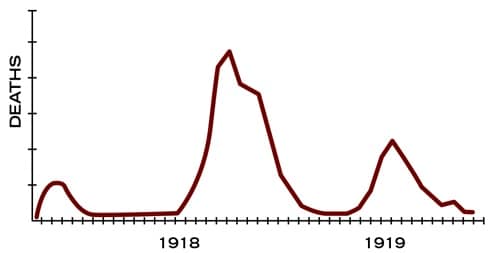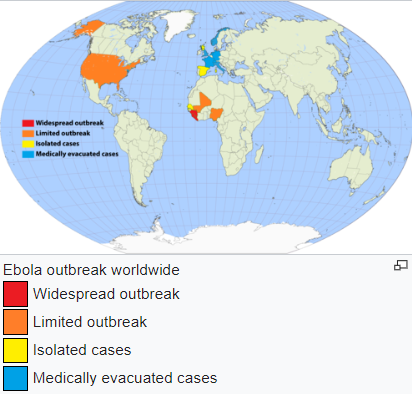In history, humanity has faced countless challenges of which, we all worked together to find a path of success. One of the categories of challenges faced, is Pandemics. This is something which has both devastated the economy yet also presented the power of humanity against worldwide catastrophic pandemics. So, here is a list of detrimental pandemics we faced since the 14th century.
Disclaimer – Figures may not be accurate
The Black Death
This bacterial infection damaged the population by a significant amount. It started in the mid-1300s and was predominantly causing harm to much of Europe.
- This disease was at its peak period between 1346-1353 and resulted in the loss of 30%-60% of the population of Europe
- The population of the world decreased from approximately 475 million to 350–375 million in the 14th century.
- The main symptoms were swelling in the armpit, diarrhoea, nausea, vomiting or fever.

This plague came to a halt as both infected and healthy people quarantined themselves. Moreover, there was a gradual improvement in public hygiene which was also a reason for the Black death to decline. However, there have still been reported cases of the Plague by the World Health Organisation even now. Between 2010-15 there were 3248 cases of which 584 were deaths.
Third plague pandemic
This disease comes under the Bubonic Plague category which is a form of bacteria, it started in Yunnan, China in 1855. Many individuals were affected especially in India, as China and India are neighbouring countries. This also included the British being affected as it was around this time that the British were ruling India.
- Over 12 million people were killed, with approximately 10 million people in India
According to the WHO, the pandemic was considered active until 1960 when worldwide casualties dropped to 200 per year, but it isn’t as severe now as it was before.
1889–1890 Flu pandemic(Russian Flu)
This disease was caused because of Influenza which is a virus. This is different from the Russian Flu during 1977–78 as it was a different time and the 1889-1890 Flu caused more deaths. The first case was reported in Bukhara, Russian Empire, in May 1889.
- It accounted for at least 1 million deaths worldwide
This virus was the last largest pandemic of the 19th century. This virus wasn’t over yet though as it came back in subsequent years. However, many people were immune to it as they have faced it when it attacked in 1889-90.
Smallpox(1700-1900)
Smallpox is a viral disease which dates back to prehistoric events and times like the Egyptians. It was indeed a very damaging disease and caused losses of many lives, especially during 1877-1977.
- During the 18th century, the disease killed an estimated 400,000 Europeans each year
- In the 20th century alone, it is estimated that smallpox was responsible for 300 million deaths

However, after this devastation, we found a successful vaccine so the WHO(World Health Organisation) declared the global eradication of smallpox in 1979.
Encephalitis lethargica pandemic/epidemic
This disease was first discovered in Europe between 1916-1917 and continued to the 1930s. This disease is known to be an infectious virus which caused excessive sleepiness, fever and many other symptoms.
- 1 million deaths due to this disease
This disease affected many people worldwide yet scientists still find this one strange. There haven’t been many cases of this disease since it’s major outbreak at the beginning of the 20th century.
Influenza A virus subtype H1N1(Spanish Flu)
This disease lasted from January 1918 to December 1920 just at the end of World War 1. It is unknown where the disease started, but, it was first observed in Europe, then it gradually spread across to America and parts of Asia in just a matter of months. This disease managed to affect everyone, from the elderly to adults and child. It’s known to be one of the most deadly viruses humanity has faced to date!
- The virus infected as much as 40% of the global population over 18 months
- The death toll is estimated to be somewhere between 17 million – 50 million
- There were approximately 500 million cases of the disease which was 1/4 of the population during the time

Why was it called the Spanish Flu? Well, you’d be surprised to know but the virus didn’t start in Spain. In fact, Spain was one of the neutral countries of World War 1. So, it was just a widespread misunderstanding because during the time of the virus Spain journalists were the only country reporting on a widespread flu outbreak in the spring of 1918, hence it was known as the ‘Spanish Flu’.
During this time there were no antibiotics or vaccines to cure the disease so the spread was exponential which meant soldiers could easily be infected. Moreover, considering it was at the end of World War 1 that this disease struck the lack of hygiene during the war led to the spread to be rapid. Therefore, the only way to stop the spread was by people quarantining.
Influenza A virus subtype H2N2(Asian Flu)
This is also another virus which was first identified in East Asia in late February 1957. It quietly spread across the world and particularly affected the United States.
- It caused the death of almost 1 million people worldwide
- 70000 people died in the United States

Vaccine production for the virus was developed relatively quickly as it started sometime in late May 1957. This was due to some advances in technology. So the disease came to a halt yet it affected many people.
Influenza A virus subtype H3N2(Hong Kong Flu)
This is also a viral disease which originated in China in July 1968 and lasted until 1969–70. This was the third influenza pandemic to occur in the 20th century. This virus is suspected that it evolved from the Influenza A virus subtype H2N2 to Influenza A virus subtype H3N2.
- Estimated 1 million people died worldwide
- Within 2 weeks of the outbreak 500000 cases were reported
This virus still exists but particularly strikes during the flu season(generally lasting between October-April).
HIV/AIDS
Firstly, HIV( Human Immunodeficiency Virus) and AIDS(Acquired Immune Deficiency Syndrome) are different from each other. AIDS is caused due to HIV and it results to your immune system weakening. HIV is a virus which is an STI(sexually transmitted disease). It is believed that this disease originated from Kinshasa in the Democratic Republic of Congo as HIV crossed species from chimpanzees to humans. Now, this is a global pandemic with many cases and deaths across the globe.
- As of 2018, approximately 37.9 million people are infected with HIV globally.
- 770,000 deaths from AIDS in 2018

As of now, there is no cure for the virus, however, there are some medications which control HIV and enable the infected people to live longer and healthier.
Pandemic H1N1/09 virus(Swine Flu)
This is a virus that appeared to be a new strain of the H1N1 virus in 1918-1920 and originated in Mexico in April 2009. It was given the name ‘Swine Flu’ because people got it by contact with pigs. It spread rapidly across the country because it was a new virus which young people weren’t immune to but most of the elder were immune to it as they have antibodies against it possibly due to its presence in 1918-20. Due to its rapid spread, the disease was considered a global pandemic in June 2009.
- Worldwide, 18,036 people died from pandemic swine flu

When this disease got to its peak and we were getting more information about the virus so the medical researchers could compose a vaccine. Therefore, on 10 August 2010, the World Health Organization (WHO) declared the pandemic officially over as there were fewer cases.
The Middle East respiratory syndrome (MERS-Cov)
This virus was found in Saudi Arabia in 2012 and it’s also known as the ‘Camel Flu’ because the cause of the virus seemed to be between Camels and humans. However, we don’t know exactly how the transmission led to the disease.
- The disease spread to 27 countries
- Since January 2020 there have been a total of 2519 laboratory-confirmed cases of Middle East respiratory syndrome (MERS)
Even now there are cases of this disease but most of the cases are mild and it doesn’t concern many people. Additionally, the risk of getting this disease is very low compared to others.
Ebola virus pandemic/epidemic
This disease was the most widespread outbreak of the Ebola virus. It primarily affected West Africa between 2013-2016. It is transmitted by mosquitoes which infect you with the virus.
- As of 8 May 2016, the World Health Organization (WHO) and respective governments reported a total of 28,646 suspected cases and 11,323 deaths

During the time of the disease, a vaccine was immediately being developed and was soon in use. 300000 vaccines have been stockpiled and have been used on infected individuals so we could overcome the disease.
COVID-19
This is the virus we are currently facing(29/03/20) 00:00 and it’s quite similar to SARS or MERS as they all come under the same family of Coronavirus. To find out more please go to: https://www.karsidonline.com/lets-fight-covid-19/
It doesn’t end there, there are innumerable diseases that humanity has to battle against of which we have successfully strived through. Both diseases and humans evolve and achieve stronger traits; so let’s keep going and defeat these diseases as they stumble upon us.


Leave a Reply